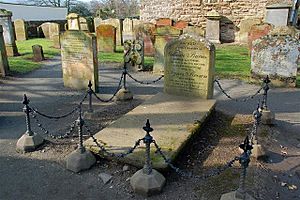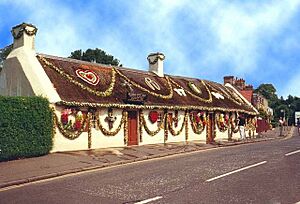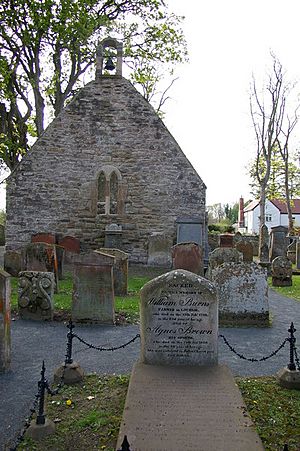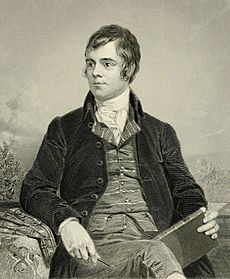William Burnes facts for kids
Quick facts for kids
William Burnes
|
|
|---|---|

William Burnes' grave in Alloway Kirk
|
|
| Born | 11 November 1721 Dunnottar, Kincardineshire, Scotland
|
| Died | 13 February 1784 (aged 62) Lochlea, South Ayrshire, Scotland
|
| Occupation | Gardener and farmer |
| Spouse(s) | Agnes Broun |
| Children | 7, including Robert, Gilbert, Agnes, and Isabella |
| Relatives | Robert Burnes (brother) |
William Burnes (born 11 November 1721 – died 13 February 1784) was the father of the famous Scottish poet, Robert Burns. William was born in Dunnottar, Scotland. He learned to be a gardener and later became a tenant farmer in Ayrshire. He always spelled his last name 'Burnes', but his son Robert used the spelling 'Burns'.
Contents
William's Life Story
William Burnes had a good basic education for his time. He was very good at reading, writing, and math. His family might have supported the Jacobite cause, which was a political movement in Scotland. Because of this, William needed a special paper from local landowners saying he was a "well-inclined lad."
In 1748, William's father, Robert Burnes, lost his farm due to money problems after a big uprising. William then moved to Edinburgh, where he worked as a gardener for two years. He helped design gardens, including part of a park now called The Meadows.
After Edinburgh, William moved to Ayrshire. He worked for the Laird of Fairlie in 1750 and then near Maybole. He was a hard worker and received a good report from the local church leaders. In 1754, he worked for the Crawfords of Doonside for two years. He saved his money because he wanted to start his own plant nursery. He bought about 7.5 acres of land in Alloway for this purpose.
William also worked as a head gardener and overseer at Doonholm Estate for two years. He was in charge of planning gardens, planting trees, building roads, and organizing farms. Later, in 1775 and 1776, he got a job from the Ayr Town Council to design a new road called Greenfield Avenue. This work helped him earn enough money to buy the land in Alloway.

William's Marriage and Family
William was a tall, quiet man. In 1757, he started building a small, two-room cottage on his land in Alloway. He met Agnes Broun at a fair in Maybole in 1756. Agnes was 24, lively, and had red hair and brown eyes. William was 36. They got married on 15 December 1757. Agnes was a farmer's daughter from Kirkoswald. They were married for 26 years until William's death.
Their first child, Robert, was born on 25 January 1759. They had six more children: Gilbert (1760), Agnes (1762), Annabella (1764), William (1767), John (1769), and Isabella (1771).
By 1765, their cottage in Alloway was too small for their growing family. William leased Mount Oliphant farm, which was about two miles away. The landlord lent him money to buy farm animals and supplies. William also briefly worked for the council, collecting information for a census.
Later, William had trouble paying his rent for Mount Oliphant. The landlord's agent was worried, but they worked it out. William used his Alloway cottage as a guarantee for the debt. In 1777, he moved his family to Lochlea, South Ayrshire.
Legal Troubles
William worked hard to improve the farm at Lochlea. But after four years, he fell behind on his rent again. His landlord, David McLure, took him to court. William fought the case and eventually won his appeal in January 1784. He paid the rent he owed, and the court recognized his expenses for improving the farm.
William's Death
William Burnes became very ill and passed away on 13 February 1784. Before he died, he worried about one of his children. When Robert asked who, William said it was him. This made Robert very sad.
William was buried in the old Alloway Kirk, a churchyard he had helped to protect years earlier. His original gravestone was taken by people who wanted souvenirs. The one there now is the third stone.
How William Influenced Robert Burns

William Burnes was a dedicated father. He taught his children reading, writing, math, geography, and history. He even wrote a special book called A Manual of Religious Belief for them to learn from.
William also paid for Robert and Gilbert to be taught by John Murdoch. John Murdoch opened a school in Alloway in 1763 and taught Latin, French, and math. Robert also had some home education. In 1772, William sent Robert to Dalrymple Parish School for a summer. The next year, Robert stayed with John Murdoch for three weeks to study more.
John Murdoch spoke highly of William, calling him "a tender and affectionate father." He believed that William's small cottage held "a larger portion of content than in any palace in Europe."
William's daughter, Isabella, remembered him as cheerful and kind. He loved to make his children happy and was good at telling jokes. He rarely got angry.
However, William did not like that Robert attended a dancing class in Tarbolton. Robert later wrote that his father had a strong dislike for these classes. Robert went anyway, which he later regretted, saying his father "took a kind of dislike to me" after that.
Robert Burns later said that his father was "by far the best of the human race" he had ever known. He admired his father's kindness and how he guided his children with love, not by forcing them. Robert wrote these lines for his father's gravestone:
"O ye whose cheek the tear of pity stains,
Draw near with pious rev'rence, and attend!
Here lie the loving husband's dear remains,
The tender father, and the gen'rous friend.
The pitying heart that felt for human woe,
The dauntless heart that fear'd no human pride,
The friend of man – to vice alone a foe;
'For even his failings lean'd to virtue's side'."
See also
- Jean Armour
- Agnes Broun
- Isabella Burns
- Robert Burnes
- Elizabeth Paton
- Robert Burnes



